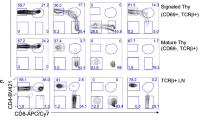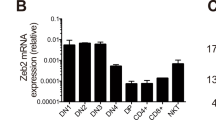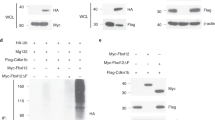Abstract
Signaling via the pre-T cell receptor (pre-TCR) regulates survival, proliferation, allelic exclusion and differentiation of thymocytes. The role played by the adapter protein Shc in T cells has remained controversial, and its role in pre-TCR signaling has not been addressed. We examined Shc function in thymic T cell development using two genetic approaches. Cre-loxP–mediated inducible expression in transgenic mice of a phosphorylation-defective mutant of Shc impaired signaling through the pre-TCR as well as subsequent proliferation and differentiation. Conditional deletion of the Shc locus in thymocytes also affected thymic maturation at the same pre-TCR developmental stage. Thus, both Shc expression and its tyrosine phosphorylation play an essential and nonredundant role in thymic T cell development.
This is a preview of subscription content, access via your institution
Access options
Subscribe to this journal
Receive 12 print issues and online access
$209.00 per year
only $17.42 per issue
Buy this article
- Purchase on Springer Link
- Instant access to full article PDF
Prices may be subject to local taxes which are calculated during checkout




Similar content being viewed by others
References
Kruisbeek, A.M. et al. Branching out to gain control: how the pre-TCR is linked to multiple functions. Immunol. Today 21, 637–644 (2000).
von Boehmer, H. et al. Pleiotropic changes controlled by the pre-T-cell receptor. Curr. Opin. Immunol. 11, 135–142 (1999).
Cantrell, D. Trangenic analysis of thymocyte signal transduction. Nature Rev. Immunol. 2, 20–27 (2002).
Alberola-Ila, J., Forbush, K.A., Seger, R., Krebs, E.G. & Perlmutter, R.M. Selective requirement for MAP kinase activation in thymocyte differentiation. Nature 373, 620–623 (1995).
Crompton, T., Gilmour, K.C. & Owen, M.J. The MAP kinase pathway controls differentiation from double-negative to double-positive thymocyte. Cell. 86, 243–251 (1996).
Michie, A.M., Trop, S., Wiest, D.L. & Zuniga-Pflucker, J.C. Extracellular signal-regulated kinase (ERK) activation by the pre-T cell receptor in developing thymocytes in vivo. J. Exp. Med. 190, 1647–1656 (1999).
Swat, W., Shinkai, Y., Cheng, H. L., Davidson, L. & Alt, F.W. Activated Ras signals differentiation and expansion of CD4+8+ thymocytes. Proc. Natl. Acad. Sci. USA 93, 4683–4687 (1996).
Luzi, L., Confalonieri, S., Di Fiore, P.P. & Pelicci, P.G. Evolution of Shc functions from nematode to human. Curr. Opin. Genet. Dev. 10, 668–674 (2000).
Ravichandran, K.S. Signaling via Shc family adapter proteins. Oncogene 20, 6322–6330 (2001).
Pelicci, G. et al. A novel transforming protein (SHC) with an SH2 domain is implicated in mitogenic signal transduction. Cell 70, 93–104 (1992).
Gotoh, N., Tojo, A. & Shibuya, M. A novel pathway from phosphorylation of tyrosine residues 239/240 of Shc, contributing to suppress apoptosis by IL-3. EMBO J. 15, 6197–6204 (1996).
van der Geer, P., Wiley, S., Gish, G.D. & Pawson, T. The Shc adaptor protein is highly phosphorylated at conserved, twin tyrosine residues (Y239/240) that mediate protein-protein interactions. Curr. Biol. 6, 1435–1444 (1996).
Rozakis-Adcock, M. et al. Association of the Shc and Grb2/Sem5 SH2-containing proteins is implicated in activation of the Ras pathway by tyrosine kinases. Nature 360, 689–692 (1992).
Rozakis-Adcock, M., Fernley, R., Wade, J., Pawson, T. & Bowtell, D. The SH2 and SH3 domains of mammalian Grb2 couple the EGF receptor to the Ras activator mSos1. Nature 363, 83–85 (1993).
Gotoh, N., Toyoda, M. & Shibuya, M. Tyrosine phosphorylation sites at amino acids 239 and 240 of Shc are involved in epidermal growth factor-induced mitogenic signaling that is distinct from Ras/mitogen-activated protein kinase activation. Mol. Cell. Biol. 17, 1824–1831 (1997).
Lai, K.M. & Pawson, T. The ShcA phosphotyrosine docking protein sensitizes cardiovascular signaling in the mouse embryo. Genes Dev. 14, 1132–1145 (2000).
Galandrini, R. et al. Selective binding of shc-SH2 domain to tyrosine-phosphorylated ζ but not γ-chain upon CD16 ligation on human NK cells. J. Immunol. 159, 3767–3773 (1997).
Ravichandran, K.S. et al. Interaction of Shc with the ζ chain of the T cell receptor upon T cell activation. Science 262, 902–925 (1993).
Plyte, S. et al. Constitutive activation of the Ras/MAP kinase pathway and enhanced TCR signaling by targeting the Shc adaptor to membrane rafts. Oncogene 19, 1529–1537 (2000).
Walk, S.F., March, M.E. & Ravichandran, K.S. Roles of Lck, Syk and ZAP-70 tyrosine kinases in TCR-mediated phosphorylation of the adapter protein Shc. Eur. J. Immunol. 28, 2265–2275 (1998).
Pratt, J.C. et al. Requirement for Shc in TCR-mediated activation of a T cell hybridoma. J. Immunol. 163, 2586–2591 (1999).
Northrop, J.P., Pustelnik, M.J., Lu, A.T. & Grove, J.R. Characterization of the roles of SH2 domain-containing proteins in T-lymphocyte activation by using dominant negative SH2 domains. Mol. Cell. Biol. 16, 2255–2263 (1996).
Osman, N., Lucas, S.C., Turner, H. & Cantrell, D. A comparison of the interaction of Shc and the tyrosine kinase ZAP-70 with the T cell antigen receptor ζ chain tyrosine-based activation motif. J. Biol. Chem. 270, 13981–13986 (1995).
Clements, J.L., Boerth, N.J., Lee, J.R. & Koretzky, G.A. Integration of T cell receptor-dependent signaling pathways by adapter proteins. Annu. Rev. Immunol. 17, 89–108 (1999).
Shinkai, Y. & Alt, F.W. CD3ε-mediated signals rescue the development of CD4+CD8+ thymocytes in RAG-2−/− mice in the absence of TCR β chain expression. Int. Immunol. 6, 995–1001 (1994).
Lakso, M. et al. Targeted oncogene activation by site-specific recombination in transgenic mice. Proc. Natl. Acad. Sci. USA 89, 6232–6236 (1992).
Lee, P.P. et al. A critical role for dnmt1 and DNA methylation in T cell development, function, and survival. Immunity 15, 763–774 (2001).
Kuhn, R., Schwenk, F., Aguet, M. & Rajewsky, K. Inducible gene targeting in mice. Science 269, 1427–1429 (1995).
Gomez, M., Tybulewicz, V. & Cantrell, D.A. Control of pre-T cell proliferation and differentiation by the GTPase Rac-I. Nature Immunol. 1, 348–352 (2000).
Tomlinson, M.G., Lin, J. & Weiss, A. Lymphocytes with a complex: adapter proteins in antigen receptor signaling. Immunol. Today 21, 584–591 (2000).
Zhang, W. & Samelson, L.E. The role of membrane-associated adaptors in T cell receptor signalling. Semin. Immunol. 12, 35–41 (2000).
Osman, N., Turner, H., Lucas, S., Reif, K. & Cantrell, D.A. The protein interactions of the immunoglobulin receptor family tyrosine- based activation motifs present in the T cell receptor ζ subunits and the CD3 γ, δ and ε chains. Eur. J. Immunol. 26, 1063–1068 (1996).
Pacini, S. et al. Tyrosine 474 of ZAP-70 is required for association with the Shc adaptor and for T-cell antigen receptor-dependent gene activation. J. Biol. Chem. 273, 20487–20493 (1998).
Ravichandran, K.S., Lorenz, U., Shoelson, S.E. & Burakoff, S.J. Interaction of Shc with Grb2 regulates the Grb2 association with mSOS. Ann. NY Acad. Sci. 766, 202–203 (1995).
Dower, N.A. et al. RasGRP is essential for mouse thymocyte differentiation and TCR signaling. Nature Immunol. 1, 317–321 (2000).
Zhang, W., Sloan-Lancaster, J., Kitchen, J., Trible, R.P. & Samelson, L.E. LAT: the ZAP-70 tyrosine kinase substrate that links T cell receptor to cellular activation. Cell 92, 83–92 (1998).
Gu, H. et al. New role for Shc in activation of the phosphatidylinositol 3–kinase/Akt pathway. Mol. Cell. Biol. 20, 7109–7120 (2000).
Luschnig, S., Krauss, J., Bohmann, K., Desjeux, I. & Nusslein-Volhard, C. The Drosophila SHC adaptor protein is required for signaling by a subset of receptor tyrosine kinases. Mol. Cell 5, 231–241 (2000).
Acknowledgements
We thank C. Wilson for the lck-Cre transgenic mouse line; D. Wiest for the pre-T cell line; M. McDuffie for the RAG-1−/− mice; the Transgenic Mouse Core Facility at the University of Virginia for their assistance; B. Neel, U. Lorenz and S. Burakoff for comments on the manuscript; and the members of the Ravichandran and Bender labs for helpful discussions. Supported by grants from the National Institutes of Health: GM-55761 to K. S. R. and CA85842 to T. P. B.
Author information
Authors and Affiliations
Corresponding author
Ethics declarations
Competing interests
The authors declare no competing financial interests.
Supplementary information
Web Fig. 1.
A second independent ShcFFF transgenic mouse line shows a similar defect in thymic development. (a) Increased percentage of DN thymocytes in lck-Cre-ShcFFF mice. Total thymocytes from ShcFFF and lck-Cre-ShcFFF mice were analyzed for CD4 and CD8 expression by flow cytometry. The percentages of cells in each quadrant as well as the total number of thymocytes from individual mice are shown. The data are representative of three independent analyses. (b) CD25 and CD44 surface expression in DN thymocyte subsets from ShcFFF and lck-Cre-ShcFFF mice were analyzed by flow cytometry (from the same mice in a). Sustained high expression of CD25 in DN subsets of lck-Cre-ShcFFF double-transgenic mice was also seen (as shown in Figure 3a and in the conditional Shc knockout mice). (JPG 103 kb)
Web Fig. 2.
Targeting of the Shc1 locus in ES cells. (a) Southern blot for homologous recombination. DNA from G418-resistant ES clones were digested with SphI and hybridized with probe 1. The 11-kb and 3.8-kb bands represented the wild-type and targeted Shc1 alleles, respectively. (b) Southern blot for homologous recombinant ES clones retaining the inserted loxP site in genomic Shc1 intron 1. DNA from ES clones with the homologous recombination (HR) was cut with BglII and hybridized with probe 2. The 12.3-kb band was generated from the ES clones with homologous recombination but which lost the inserted loxP site 5' of exon 1 during the homologous recombination process. The 9.8-kb band was generated from HR-ES clones which retained the inserted loxP sites during the homologous recombination process. The 10.5-kb band was generated from the wild-type alleles. (c) Southern blot for Cre-mediated deletion in ES cells. After transient transfection of pI-Cre into clone 141, DNA from the neomycin-sensitive ES clones were cut with BglII and hybridized with probe 2. The bands corresponding to WT, floxed and deleted alleles are indicated. *A nonspecific band present in all clones. (d) PCR screen for the floxed Shc1 allele in tail DNA. The forward primer used was 5'-CAGCCGGCCAACTCTAAG-3' and the reverse primer was 5'-GCCCTCGGACAGAGCAATCATGTC-3'. The bands representing the WT and floxed alleles are indicated. (JPG 38 kb)
Web Fig. 3.
Analysis of peripheral T cells from lck-Cre-ShcFFF mice. (a) Single-cell suspensions of splenocytes were stained with anti-CD4 and anti-CD8 and analyzed by flow cytometry. Only a modest and inconsistent decrease in the numbers of T cells was found in the periphery in contrast to the significant decrease in the thymus. The negligible decrease in peripheral T cell numbers in the lck-Cre-ShcFFF mice is most likely due to the homeostatic expansion of T cells that leave the thymus and failed to delete the STOP cassette. (b) Splenic T cells from the control and the lck-Cre-ShcFFF mice were analyzed for proliferation after stimulation with anti-CD3 ± IL-2. 96-well plates were coated with 3 μg/ml of anti-CD3 or PBS control. Splenocytes (2 × 105) were plated onto each well in triplicate in the presence or absence of 50 U/ml of recombinant human IL-2. After 72 h of incubation, the cells were pulsed with 1 μCi of [3H]thymidine and 18 h later the incorporation was measured. There was no apparent difference in the proliferative capacity of the peripheral T cells between the control and the lck-Cre-ShcFFF mice. (JPG 41 kb)
Web Fig. 4.
Expression of ShcFFF does not result in increased apoptosis of DN3 thymocytes, as determined by annexin V staining. Single-cell suspension of thymocytes prepared from ShcFFF alone and lck-Cre-ShcFFF mice were analyzed by annexin V staining either fresh out of the animal (0 h) or subsequent to cell culture for the indicated times. The DN3 cells were gated and the percentage of annexin V-positive and propidium iodide-negative cells was determined. There was no significant difference between control and lck-Cre-ShcFFF thymocytes after 24 h in culture. The data presented are representative of three independent experiments. (JPG 76 kb)
Web Fig. 5.
ShcFFF does not affect γδ T cell development. (a) No apparent difference in γδ T cell numbers in the thymus between control and lck-Cre-ShcFFF mice. CD4-CD8- (DN) thymocytes from control mice (lck-Cre alone or ShcFFF alone) or lck-Cre-ShcFFF double-transgenic mice were analyzed for percentage of cells expressing TCRγ δ and CD3. The data are representative of three independent experiments. The absolute numbers of γδ T cells in the control mice were 6 × 105 ± 0.55 × 105 (n = 3) and in the lck-Cre-ShcFFF mice were 5.8 × 105 ± 0.7 × 105 (n = 3). Of note, the lck-Cre-ShcFFF mouse shown above had a severe decrease in total thymocyte numbers (7 × 106) compared to the control mouse (2 × 108). (b) Distribution of αβ and γδ T cells in the intestinal intraepithelial lymphocyte (IEL) population in the lck-Cre-ShcFFF double-transgenic mice. IEL isolated from the control mice and the lck-Cre-ShcFFF mice were analyzed for the composition of αβ and γδ TCR expressing cells with the anti-TCRαβ antibody H57-597 (BD-Pharmingen) and anti-TCRγδ antibody GL3 (Caltag). The data presented are representative of three independent control and experimental mice that were analyzed. The mean percentage of γδ T cells within the IEL compartment in the control mice was 56 ± 12 and 49 ± 7 in the lck-Cre-ShcFFF. (JPG 68 kb)
Rights and permissions
About this article
Cite this article
Zhang, L., Camerini, V., Bender, T. et al. A nonredundant role for the adapter protein Shc in thymic T cell development. Nat Immunol 3, 749–755 (2002). https://doi.org/10.1038/ni820
Received:
Accepted:
Published:
Issue Date:
DOI: https://doi.org/10.1038/ni820
This article is cited by
-
SHCBP1 promotes synovial sarcoma cell metastasis via targeting TGF-β1/Smad signaling pathway and is associated with poor prognosis
Journal of Experimental & Clinical Cancer Research (2017)
-
A role for Peroxisome Proliferator-Activated Receptor Beta in T cell development
Scientific Reports (2016)
-
CXCR4 acts as a costimulator during thymic β-selection
Nature Immunology (2010)
-
Cooperation and selectivity of the two Grb2 binding sites of p52Shc in T-cell antigen receptor signaling to Ras family GTPases and Myc-dependent survival
Oncogene (2005)
-
Stem Cells for neurodegenerative diseases: Hopes and reality
Rendiconti Lincei (2005)



